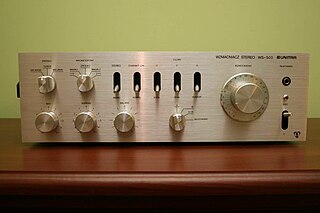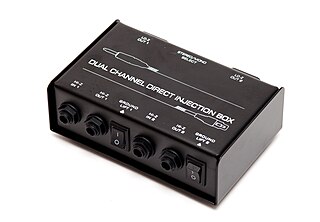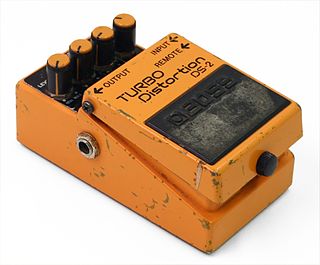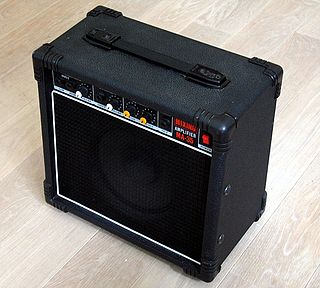Related Research Articles

An effects unit or effects pedal is an electronic device that alters the sound of a musical instrument or other audio source through audio signal processing.

An electric guitar is a guitar that requires external amplification in order to be heard at typical performance volumes, unlike a standard acoustic guitar. It uses one or more pickups to convert the vibration of its strings into electrical signals, which ultimately are reproduced as sound by loudspeakers. The sound is sometimes shaped or electronically altered to achieve different timbres or tonal qualities on the amplifier settings or the knobs on the guitar from that of an acoustic guitar. Often, this is done through the use of effects such as reverb, distortion and "overdrive"; the latter is considered to be a key element of electric blues guitar music and jazz and rock guitar playing.

The guitar is a fretted musical instrument that typically has six strings. It is usually held flat against the player's body and played by strumming or plucking the strings with the dominant hand, while simultaneously pressing selected strings against frets with the fingers of the opposite hand. A plectrum or individual finger picks may also be used to strike the strings. The sound of the guitar is projected either acoustically, by means of a resonant chamber on the instrument, or amplified by an electronic pickup and an amplifier.

String instruments, stringed instruments, or chordophones are musical instruments that produce sound from vibrating strings when a performer plays or sounds the strings in some manner.

An audio power amplifier is an electronic amplifier that amplifies low-power electronic audio signals, such as the signal from a radio receiver or an electric guitar pickup, to a level that is high enough for driving loudspeakers or headphones. Audio power amplifiers are found in all manner of sound systems including sound reinforcement, public address and home audio systems and musical instrument amplifiers like guitar amplifiers. It is the final electronic stage in a typical audio playback chain before the signal is sent to the loudspeakers.

An instrument amplifier is an electronic device that converts the often barely audible or purely electronic signal of a musical instrument into a larger electronic signal to feed to a loudspeaker. An instrument amplifier is used with musical instruments such as an electric guitar, an electric bass, electric organ, synthesizers and drum machine to convert the signal from the pickup or other sound source into an electronic signal that has enough power, due to being routed through a power amplifier, capable of driving one or more loudspeaker that can be heard by the performers and audience.

A guitar amplifier is an electronic device or system that strengthens the electrical signal from a pickup on an electric guitar, bass guitar, or acoustic guitar so that it can produce sound through one or more loudspeakers, which are typically housed in a wooden cabinet. A guitar amplifier may be a standalone wood or metal cabinet that contains only the power amplifier circuits, requiring the use of a separate speaker cabinet–or it may be a "combo" amplifier, which contains both the amplifier and one or more speakers in a wooden cabinet. There is a wide range of sizes and power ratings for guitar amplifiers, from small, lightweight "practice amplifiers" with a single 6-inch speaker and a 10-watt amp to heavy combo amps with four 10-inch or four 12-inch speakers and a 100-watt amplifier, which are loud enough to use in a nightclub or bar performance.

A DI unit is an electronic device typically used in recording studios and in sound reinforcement systems to connect a high-output impedance, line level, unbalanced output signal to a low-impedance, microphone level, balanced input, usually via an XLR connector and XLR cable. DIs are frequently used to connect an electric guitar or electric bass to a mixing console's microphone input jack. The DI performs level matching, balancing, and either active buffering or passive impedance matching/impedance bridging to minimize unwanted noise, distortion, and ground loops. DI units are typically metal boxes with input and output jacks and, for more expensive units, “ground lift” and attenuator switches.

Jazz bass is the use of the double bass or electric bass to improvise accompaniment ("comping") basslines and solos in a jazz or jazz fusion style. Players began using the double bass in jazz in the 1890s to supply the low-pitched walking basslines that outlined the chord progressions of the songs. From the 1920s and 1930s Swing and big band era, through 1940s Bebop and 1950s Hard Bop, to the 1960s-era "free jazz" movement, the resonant, woody sound of the double bass anchored everything from small jazz combos to large jazz big bands.

A pickup is a transducer that captures or senses mechanical vibrations produced by musical instruments, particularly stringed instruments such as the electric guitar, and converts these to an electrical signal that is amplified using an instrument amplifier to produce musical sounds through a loudspeaker in a speaker enclosure. The signal from a pickup can also be recorded directly.

The electric upright bass (EUB) is an instrument that can perform the musical function of a double bass. It requires only a minimal or 'skeleton' body to produce sound because it uses a pickup and electronic amplifier and loudspeaker. Therefore, a large resonating structure is not required to project the sound into the air. This minimal body greatly reduces the bulk and weight of the instrument. EUBs must always be connected to an amplifier and speaker cabinet to produce an adequate audible sound. The EUB retains enough of the features of the double bass so that double bass players are able to perform on it.
Chorus is an audio effect that occurs when individual sounds with approximately the same time, and very similar pitches, converge. While similar sounds coming from multiple sources can occur naturally, as in the case of a choir or string orchestra, it can also be simulated using an electronic effects unit or signal processing device.

A bass amplifier is a musical instrument electronic device that uses electrical power to make lower-pitched instruments such as the bass guitar or double bass loud enough to be heard by the performers and audience. Bass amps typically consist of a preamplifier, tone controls, a power amplifier and one or more loudspeakers ("drivers") in a cabinet.

A guitar technician is a member of a music ensemble's road crew who maintains and sets up the musical equipment for one or more guitarists. Depending on the type and size of band, the guitar tech may be responsible for stringing, tuning, and adjusting electric guitars and acoustic guitars, and maintaining and setting up guitar amplifiers and other related electronic equipment such as effect pedals.

Distortion and overdrive are forms of audio signal processing used to alter the sound of amplified electric musical instruments, usually by increasing their gain, producing a "fuzzy", "growling", or "gritty" tone. Distortion is most commonly used with the electric guitar, but may also be used with other electric instruments such as electric bass, electric piano, synthesizer and Hammond organ. Guitarists playing electric blues originally obtained an overdriven sound by turning up their vacuum tube-powered guitar amplifiers to high volumes, which caused the signal to distort. While overdriven tube amps are still used to obtain overdrive, especially in genres like blues and rockabilly, a number of other ways to produce distortion have been developed since the 1960s, such as distortion effect pedals. The growling tone of a distorted electric guitar is a key part of many genres, including blues and many rock music genres, notably hard rock, punk rock, hardcore punk, acid rock, and heavy metal music, while the use of distorted bass has been essential in a genre of hip hop music and alternative hip hop known as "SoundCloud rap".

A guitar speaker is a loudspeaker – specifically the driver (transducer) part – designed for use in a combination guitar amplifier of an electric guitar, or for use in a guitar speaker cabinet. Typically these drivers produce only the frequency range relevant to electric guitars, which is similar to a regular woofer type driver, which is approximately 75 Hz — 5 kHz, or for electric bass speakers, down to 41 Hz for regular four-string basses or down to about 30 Hz for five-string instruments.
Re-amping is a process often used in multitrack recording in which a recorded signal is routed back out of the editing environment and run through external processing using effects units and then into a guitar amplifier and a guitar speaker cabinet or a reverb chamber. Originally, the technique was used mostly for electric guitars: it facilitates a separation of guitar playing from guitar amplifier processing—a previously recorded audio program is played back and re-recorded at a later time for the purpose of adding effects, ambiance such as reverb or echo, and the tone shaping imbued by certain amps and cabinets. The technique has since evolved over the 2000s to include many other applications. Re-amping can also be applied to other instruments and program, such as recorded drums, synthesizers, and virtual instruments.

This is a list of jazz and popular music terms that are likely to be encountered in printed popular music songbooks, fake books and vocal scores, big band scores, jazz, and rock concert reviews, and album liner notes. This glossary includes terms for musical instruments, playing or singing techniques, amplifiers, effects units, sound reinforcement equipment, and recording gear and techniques which are widely used in jazz and popular music. Most of the terms are in English, but in some cases, terms from other languages are encountered.
Amplifier modeling is the process of emulating a physical amplifier such as a guitar amplifier. Amplifier modeling often seeks to recreate the sound of one or more specific models of vacuum tube amplifiers and sometimes also solid state amplifiers.

A keyboard amplifier is a powered electronic amplifier and loudspeaker in a wooden speaker cabinet used for amplification of electronic keyboard instruments. Keyboard amplifiers are distinct from other types of amplification systems such as guitar amplifiers due to the particular challenges associated with making keyboards sound louder on stage; namely, to provide solid low-frequency sound reproduction for the deep basslines which keyboards can play and crisp high-frequency sound for the high-register notes. Another difference between keyboard amplifiers and guitar/bass amplifiers is that keyboard amps are usually designed with a relatively flat frequency response and low distortion. In contrast, many guitar and bass amp designers purposely make their amplifiers modify the frequency response, typically to "roll off" very high frequencies, and most rock and blues guitar amps, and since the 1980s and 1990s, even many bass amps are designed to add distortion or overdrive to the instrument tone.